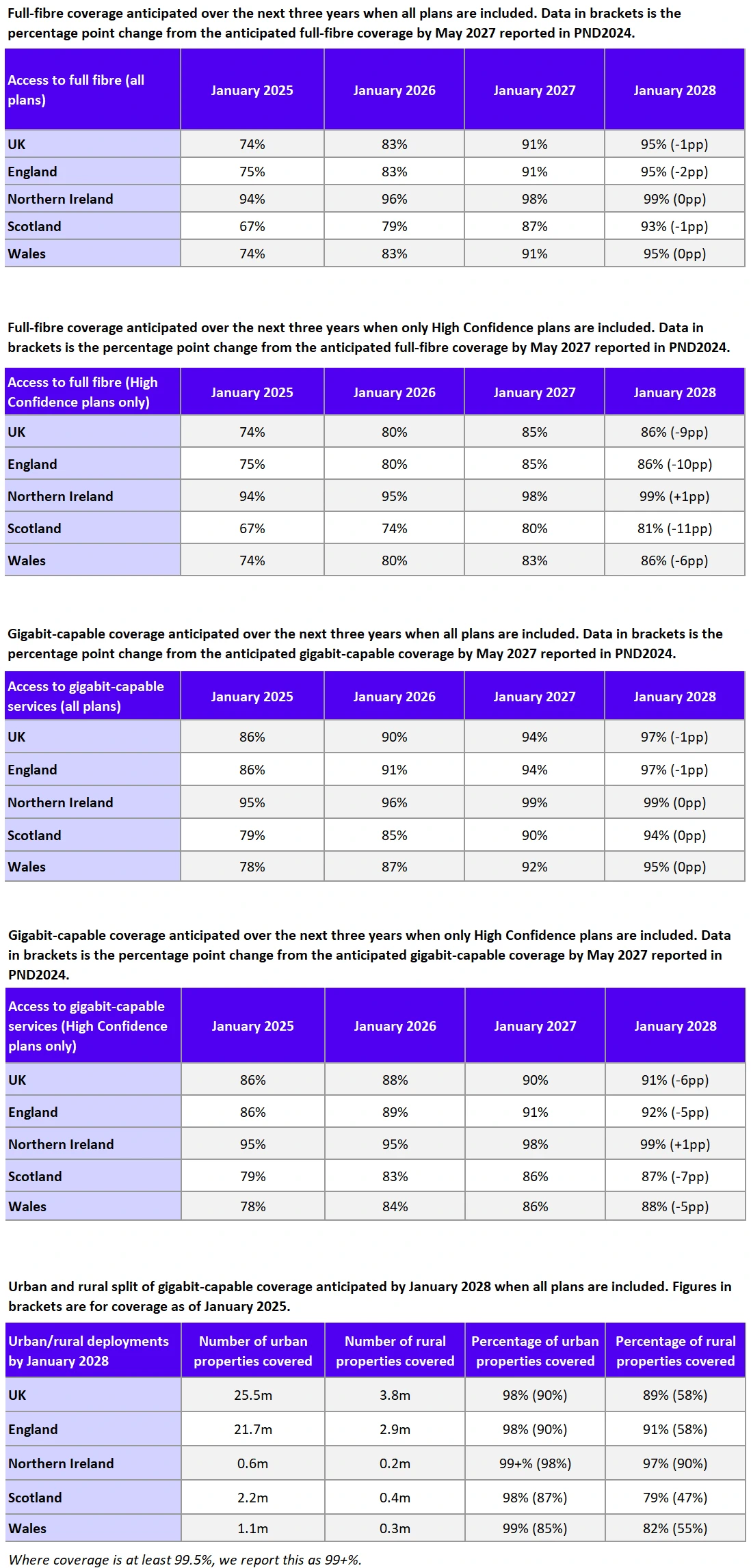Ofcom Predict 97 Percent of UK Covered by Gigabit Broadband in Jan 2028

Somehow, we overlooked that the telecoms regulator had published the fourth edition of their forecast for Planned Network Deployments, which has revised down its expectations of future coverage after UK broadband operators did the same. The report now predicts that full fibre (FTTP) lines will reach 86-95% of homes by January 2028 – rising to 91-97% for gigabit-capable networks (i.e. FTTP and Cable).
According to the regulator’s latest data to January 2025 (here), some 74% (23.68 million) of UK homes are currently within reach of a Fibre-to-the-Premises (FTTP) network (up from 62% in Jan 2024) and this rises to 86% for gigabit-capable networks (up from 80%). The latter is being driven by both FTTP from multiple operators and Virgin Media’s older DOCSIS 3.1 powered cable network (there’s a lot of overbuild between these in urban areas).
The new report goes further and, based on the stated deployment plans of network operators as of January 2025 (looking up to 3 years in advance), attempts to predict how much coverage will be achieved by January 2028. These plans include those that are privately funded as well as any plans that are supported through public funds/intervention.
Advertisement
The vast majority of this FTTP and gigabit-capable broadband coverage tends to come from commercial builds – mostly in urban areas, although rural areas will also see substantial network upgrades. The UK Government’s £5bn Project Gigabit programme is specifically focused on the final 10-20% of hardest to reach premises (i.e. aiming to extend gigabit coverage to around 99% “nationwide” by 2032).
However, we must apologise because Ofcom actually published this update in May 2025, but for some reason it was never mentioned in their email updates to us. In that sense, this news update is intended as somewhat of a catch-up piece and also helps to give context for the Government’s recent decision to push back their Project Gigabit delivery target from 2030 to 2032 (here).
As Ofcom itself explains: “Operators have revised their build plans downwards from last year, both in scope and confidence of achieving,” which we suspect can be taken as a reflection of the many news reports we’ve written over the past 2-3 years about individual network operators slowing their builds; often due to a combination of factors (i.e. rising build costs, high interest rates and strong competition in areas of overbuild).
What’s the revised projection for 2028?
If all of the planned deployments are realised, Ofcom’s report forecasts that gigabit-capable networks in urban areas could increase from 23.4 million (90%) as of January 2025 to 25.5 million (98%) by January 2028, and from 2.5 million (58%) to 3.8 million (89%) in rural areas. This picture will of course vary across regions and local authorities.
Advertisement
The following forecast splits the figures down across England, Wales, Scotland and Northern Ireland. Ofcom typically gives two figures for each technology type, which reflects the range between their most optimistic build forecast and the more pessimistic, albeit highest confidence, one. This is why the January 2028 expectations for UK gigabit coverage range from 91% (high confidence) to 97% (most optimistic). The reality may thus sit somewhere in-between.
The regulator also estimates that 79% of UK homes will have access to two or more gigabit-capable networks by the end of 2027.

Mark is a professional technology writer, IT consultant and computer engineer from Dorset (England), he also founded ISPreview in 1999 and enjoys analysing the latest telecoms and broadband developments. Find me on X (Twitter), Mastodon, Facebook, BlueSky, Threads.net and Linkedin.
« Sky UK in Talks to Acquire ITV’s Media and Entertainment Divisions
ISP KCOM Start Black Friday SALE on UK Broadband Packages »
Advertisement
Leave a Reply Cancel reply
Privacy Notice: Please note that news comments are anonymous, which means that we do NOT require you to enter any real personal details to post a message and display names can be almost anything you like (provided they do not contain offensive language or impersonate a real person's legal name). By clicking to submit a post you agree to storing your entries for comment content, display name, IP and email in our database, for as long as the post remains live.
Only the submitted name and comment will be displayed in public, while the rest will be kept private (we will never share this outside of ISPreview, regardless of whether the data is real or fake). This comment system uses submitted IP, email and website address data to spot abuse and spammers. All data is transferred via an encrypted (https secure) session.






















































Would be interesting to see what gigabit networks actually pass the regular contributors of the comments section. So my starter for 10 is Openreach & All Points Fibre Network (although as you can’t order on APFN does it really count?).
In my case, none.
None. Unfortunately for us, there is a lot of overbuild in the neighbouring areas (4-5 gigabit networks), but nothing for our house. Openreach say they are coming within the year, so we have some hope. London is still very patchy with a lot of build in some areas, and none in others.
Openreach, CityFibre and Virgin Cable. Pretty sure Virgin have done the work to upgrade to full fibre but it’s not orderable yet. (Not that I would!)
None for us too. FTTC is the only product available to us. Openreach are rolling out to our city right now but deployment seems to have slowed to crawl. We were supposed to go live in June 2025. Then revised to end of the year. Now it’s a vague ‘by end of 2026’. I’ve given up hoping to get anything better. Houses not 50 metres away can get OR FTTP, Virgin coax and APFN (which you cannot order anymore so doesn’t count I guess).
Project Gigaflop sounds about right. Cityfibre won the contract for Hampshire and as far as I know, all they’ve done so far is a handful of premises in Hayling Island.
Openreach, Pine Media, Virgin HFC and now FTTP and looks like City Fibre are busy trashing the pavement close by, so maybe they will
Also be available soon
FTTC with zero commitment or information on FTTP from OR or Project Gigaflop contractors, in rural Kent.
Starlink is available but since I won’t ever fund Muskrat is irrelevant.
Mobile Broadband 4G is live and 5G deployment is in VodaThree public plans. Three mobile networks still provide some competition unlike fibre.
I would add that the government has probably cut the funds available for Project GigaBit, given the broadened policy promises it made earlier this year, minus a proportionate expansion in the funding.
Still waiting…I assume it’s coming as Openreach are in my area again filling gaps. I’ve been in this position before and it all went quiet so I’m taking nothing for granted.
It’s probably a position to get out of, but when you check every month and nothing is planned, but all your friends and family have access to it and you don’t, it grates.